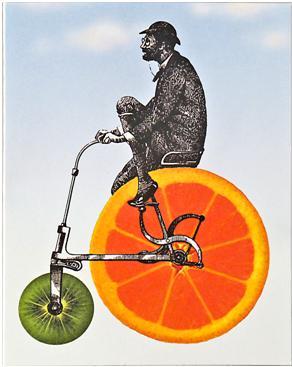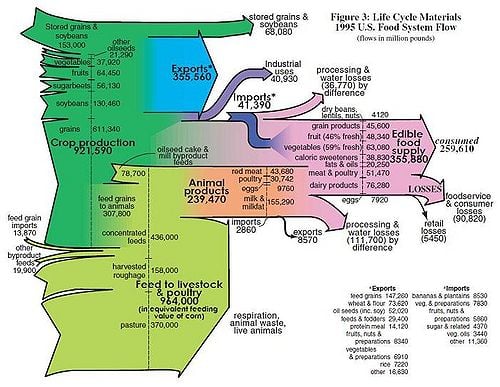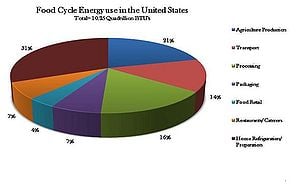
The purpose of this wiki site is to review the relevant literature of the LCA of food (Figure 1). Life cycle assessment (LCA) methodology provides an avenue of insight to global resource management strategies that are pertinent to the world today.
With respect to the LCA of food, there are a multitude of facets comprising the whole. This review will address:
- Indicators associated with food production impacts
- Mass flow of food
- Energy of food production
Methods of quantifying impacts, including:
- Carbon emissions
- Land use requirements
- Energy use
LCA Definition as Applied to the Life Cycle of Food
The LCA methodology was designed to assess the environmental impacts associated with products, processes or activities. (Lundie and Peters,[2] 2005) When the definition of the LCA is applied to the life cycle of food, each of the following life stages of a product are analyzed:
- origin
- agricultural growing and production
- food processing, packaging and distribution
- preparation and consumption
- end of life
The impacts considered to the system are biophysical in focus:
- resource depletion
- energy consumption
- water and air pollution
- human health
- waste generation
In order to further specify impacts, indicators are used to gage the degree and type of impact.
Indicators
Definition and role of indicators
An indicator is a device, mechanism, or package of information that defines the state of a system. Indicators alert changes to the system, and provide information that lends to a deeper understanding of the fluctuations within the system. To assist in the LCA of food products, indicators--such as--economy, society, and the environment are used to supply a reference point, a lens through which to view the system.
The LCA methodology is founded on the assessment of manufactured goods. The application of the LCA methodology to the food system is steeped in complications, bottlenecks and assumptions. Direct application of the LCA methodology to the global food system has not been completed, rather components have been isolated and analyzed. Some of the challenges associated with the LCA of food products are:
- determination of accurate/ appropriate system boundaries
- definition of functional units
- synergistic product allocation.
List of LCA indicators
Table 1 lists the indicators used to evaluate the different life stages of production.
- Reproductive ability of plant or animal
- % of disease resistant organisms
| Table 1: Life Cycle Sustainability Indicators for the Food System (Heller and Keoleian,[3] 2000). | Stakeholders | Life Cycle Stage | Indicators | ||
|---|---|---|---|---|---|
| Economic | Social | Environmental | |||
| Farmers, Breeders, Seed Companies | Origin of (genetic) resource– seed production, animal breeding | Degree of farmer/operator control of seed production/ breeding. | |||
| Farm operators Farm workers Ag. Industry Ag. Schools Government Animals | Agricultural growing and production | ||||
| Food processors Packaging providers Wholesalers Retailers | Food processing, packaging and distribution | ||||
| Consumers Food service Nutritionists/ Health professionals | Preparation and consumption | ||||
| Consumers Waste managers Food recovery & gleaning organizations | End of life | ||||
Follow the Food
In order to assess the life cycle of food, the life cycle for food must first be defined. The following section is an overview of the flow of food from cradle to grave. As can be seen in figure 4, food flows from cradle to grave. This section defines the individual life stages of any food product.
Origin
The origin of a food product involves either the seed production or animal breeding.
Agricultural Growing and Production
This is the farming stage of a food product's life. Farming and production requires:
- land
- labor
- capital
Food Processing Packing and Distribution
The life stage of food processing packing and distribution is a function of:
- fuel prices
- distance traveled
- medium of travel
- food weight
- package weight and material
Preparation and Consumption
The preparation and consumption stage is highly variable and, at a minimum, is a function of:
- culture
- socioeconomic influences
- individual taste
End of Life
In the event that a food product bypasses consumption, it will reach its end of life stage ultimately as a waste product. As seen in the image below, the percentage of food mass that ends up as waste is substantial.

Life Cycle Measurement
The quantitative measurement, or cost, of food is determined by various methods. The following section will examine the various standards for this measurement.
CO2 emissions
Land Use
Energy Use
One of the methods used to quantify food impacts is to follow the energy required for production. Table 2 shows two different example Swedish dinners, and the associated energy required for production, and energy received from consumption.

| Table 2: The energy required to supply a low energy and high energy dinner, with corresponding energy returns of the meals(Carlsson-Kanyama et al.,[5] 2002). | |||
|---|---|---|---|
| Meal component | Kg | MJ dietary energy (SNFA, 1996) | MJ life cycle inputs |
| Dinner: high | |||
| Beef | 0.13 | 0.80 | 9.4 |
| Rice | 0.15 | 0.68 | 1.1 |
| Tomatoes, greenhouse | 0.070 | 0.06 | 4.6 |
| Wine | 0.30 | 0.98 | 4.2 |
| Total | 0.65 | 2.51 | 19 |
| Dinner: low | |||
| Chicken | 0.13 | 0.81 | 4.37 |
| Potatoes | 0.20 | 0.61 | 0.91 |
| Carrot | 0.13 | 0.21 | 0.50 |
| Water, tap | 0.15 | 0.23 | 0.0 |
| Oil | 0.02 | 0.74 | 0.30 |
| Total | 0.60 | 2.61 | 6.1 |
- Energy inputs in the food cycle can range from 2 to 220 MJ/kg due to many factors. Some of these factors relate to animal or vegetable origin, degree of processing, type of processing and preparation and transportation distance. Energy input comparisons for the life cycle of food should be made for each meal with similar nutrient content.
- Life cycle energy input for the animal category can range from 1.8 to 7.7 MJ. A strategy for decreasing consumption of energy intensive animal products is to identify energy efficient animal alternatives.
- The total life cycle energy inputs for food per person per day range from 13 to 51 MJ. This range is for diets with a similar nutritional content and both are based on ingredients commonly available.
- Current food consumption patterns may result in life cycle energy inputs ranging from 6900 to 21,000 MJ per person per year. The differences in food consumption patterns are due to gender differences.
- Approximately a third of the total energy input for food is for sweets, snacks and drinks. Increased attention should be given to the environmental consequences of these items in a diet.
- An energy efficient diet with equal global partitioning of energy resources is possible; however, such a diet is far from average and not in line with current trends (Carlsson-Kanyama et al.,[5] 2002).
See also
References
- ↑ Feltandwireshop. 'Curated Paper Goods,' <http://web.archive.org/web/20120531011043/http://feltandwireshop.com/system/product images/1195/original/FoodCycleCard.jpg?1260998038>. April 22, 2010.
- ↑ Lundie, S., Peters, G. (2005). 'Life cycle assessment of food waste management options,' Journal of Cleaner Production. Vol. 13. pp. 275–286
- ↑ 3.0 3.1 Heller, M., Keoleian, G., (2000). 'Life Cycle-Based Sustainability Indicators for Assessment of the U.S. Food System,' Center for Sustainable Systems, University of Michigan
- ↑ Hill, H., (2008). 'Food Miles: Background and Marketing', ATTRA. National Sustainable Agriculture Information Service. www.attra.ncat.org/attra-pub/PDF/foodmiles.pdf
- ↑ 5.0 5.1 Carlsson-Kanyama, A., Ekstro, M., Shanahan, H. (2002). 'Food and life cycle energy inputs: consequences of diet and ways to increase efficiency,' Ecological Economics. Vol. 44. pp. 293-307